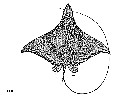Aetobatus flagellum
(Bloch & Schneider, 1801)
Longheaded eagle ray
Classification: Elasmobranchii Myliobatiformes Aetobatidae
Reference of the original description
M.E. Blochii Systema Ichthyologiae iconibus ex illustratum. Post obitum auctoris opus inchoatum absolvit, correxit, interpolavit. J.G. Schneider, Saxo: 584 p., 110 pl.
M.E. Blochii Systema Ichthyologiae iconibus ex illustratum. Post obitum auctoris opus inchoatum absolvit, correxit, interpolavit. J.G. Schneider, Saxo: 584 p., 110 pl.
Image of the original description
.jpg)
Aetobatus flagellum (Bloch & Schneider, 1801)
.jpg)
Aetobatus flagellum (Bloch & Schneider, 1801)
Synonyms / new combinations and misspellings
Aetobates flagellum, Aetobatis flagellum, Aetobatus flagellus, Raja flagellum
Aetobates flagellum, Aetobatis flagellum, Aetobatus flagellus, Raja flagellum
Description :
Citation: Aetobatus flagellum (Bloch & Schneider, 1801): In: Database of modern sharks, rays and chimaeras, www.shark-references.com, World Wide Web electronic publication, Version 01/2026
Please send your images of "Aetobatus flagellum" to info@shark-references.com

Aetobatus flagellum (Bloch & Schneider, 1801), Marve, Malad, Mumbai in fisherman's net, 29.11.2017, 50-55 cm DW © Pradip Patade, India

Aetobatus flagellum (Bloch & Schneider, 1801), Marve, Malad, Mumbai in fisherman's net, 29.11.2017, 50-55 cm DW © Pradip Patade, India
Common names
 Eagle ray,
Eagle ray,  Longheaded eagle ray,
Longheaded eagle ray,  Plain eagleray
Plain eagleray
 Eagle ray,
Eagle ray,  Longheaded eagle ray,
Longheaded eagle ray,  Plain eagleray
Plain eagleray
Short Description
Original Diagnosis of the Redescription of WHITE, W.T. & MOORE, 2013 [20020]: A small Aetobatus (attaining about 900 mm DW) with the following combination of characters: dorsal surfaces uniformly brownish, without pale spots; tail very long (1.22–2.81 times DW); stinging spine(s) relatively long (6.2–16.2% DW); head long; rostral lobe long to very long (longest in adult males) with a narrowly pointed apex; teeth plates in a single row, those in lower jaw chevron-shaped; width of lower tooth plate about two thirds mouth width; pectoral-fin radials 89–96 (excluding propterygial radials anterior of eyes); total vertebral centra (including synarcual) 85–91; males mature by about 500 mm DW and females by about 746 mm DW.
Diet: only on bivalves, especially Ruditapes philippinarum and Atrina pectinata [7087]; Age: max. 19 years (female) and 9 years (male) [7087];
Original Diagnosis of the Redescription of WHITE, W.T. & MOORE, 2013 [20020]: A small Aetobatus (attaining about 900 mm DW) with the following combination of characters: dorsal surfaces uniformly brownish, without pale spots; tail very long (1.22–2.81 times DW); stinging spine(s) relatively long (6.2–16.2% DW); head long; rostral lobe long to very long (longest in adult males) with a narrowly pointed apex; teeth plates in a single row, those in lower jaw chevron-shaped; width of lower tooth plate about two thirds mouth width; pectoral-fin radials 89–96 (excluding propterygial radials anterior of eyes); total vertebral centra (including synarcual) 85–91; males mature by about 500 mm DW and females by about 746 mm DW.
Diet: only on bivalves, especially Ruditapes philippinarum and Atrina pectinata [7087]; Age: max. 19 years (female) and 9 years (male) [7087];
Distribution
Patchily distributed in the Indo–West Pacific; known from the Western Indian Ocean, from Kuwait in the Persian Gulf to Pakistan and India; and the Eastern Indian Ocean, from India and Sri Lanka to Indonesia (Kalimantan) and Malaysia (Sarawak) [20020];
First records: 2005: Korea [16136]; 2005: Ariake Sound, Kyushu Island [7087]; Source: www.gbif.org
Patchily distributed in the Indo–West Pacific; known from the Western Indian Ocean, from Kuwait in the Persian Gulf to Pakistan and India; and the Eastern Indian Ocean, from India and Sri Lanka to Indonesia (Kalimantan) and Malaysia (Sarawak) [20020];
First records: 2005: Korea [16136]; 2005: Ariake Sound, Kyushu Island [7087]; Source: www.gbif.org
Human uses
fisheries: minor commercial; price category: medium; price reliability: very questionable: based on ex-vessel price for species in this family
fisheries: minor commercial; price category: medium; price reliability: very questionable: based on ex-vessel price for species in this family
Biology
Exhibit ovoviparity (aplacental viviparity), with embryos feeding initially on yolk, then receiving additional nourishment from the mother by indirect absorption of uterine fluid enriched with mucus, fat or protein through specialised structures [733].
Exhibit ovoviparity (aplacental viviparity), with embryos feeding initially on yolk, then receiving additional nourishment from the mother by indirect absorption of uterine fluid enriched with mucus, fat or protein through specialised structures [733].
Size / Weight / Age
Moore et al. [15172]: males: 277–580 DW and and females: 330–746 mm DW, and WHITE, W.T. & MOORE, 2013 [20020]: males: 233–543 and females: 243–578 mm DW;
Moore et al. [15172]: males: 277–580 DW and and females: 330–746 mm DW, and WHITE, W.T. & MOORE, 2013 [20020]: males: 233–543 and females: 243–578 mm DW;
Remarks
shark-references Species-ID=112;
shark-references Species-ID=112;
Parasites (arranged by Jürgen Pollerspöck)
Cestoda
Nematoda
Isopoda
Cestoda
- Polypocephalus bombayensis Shinde, Dhule & Jadhav, 1991 [16402]
Nematoda
- Echinocephalus sinensis Ko, 1975 [23996]
Isopoda
- Gnathia trimaculata Coetzee, Smit, Grutter & Davies, 2009 [17188]


















